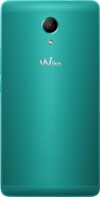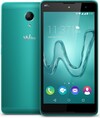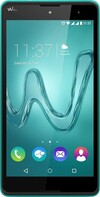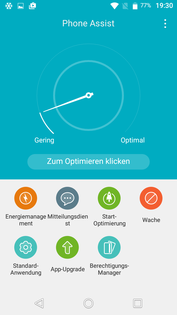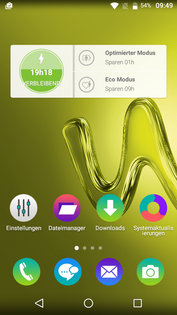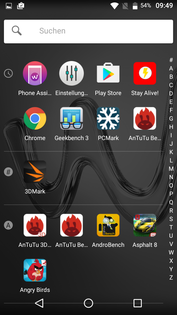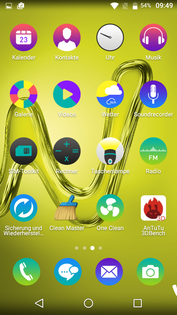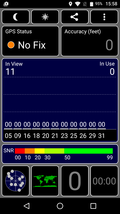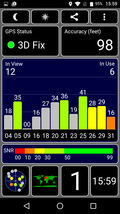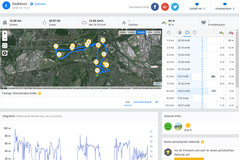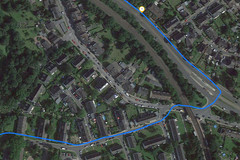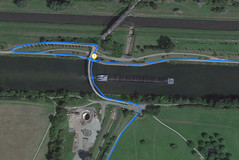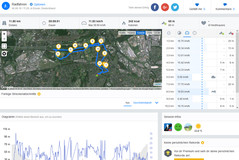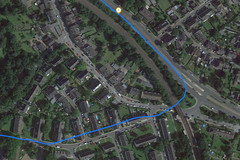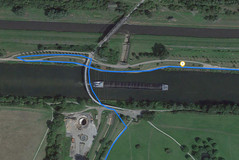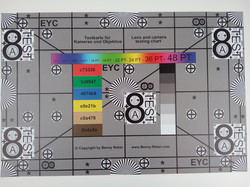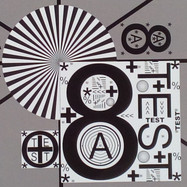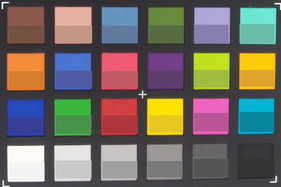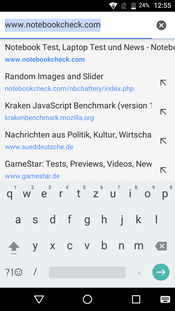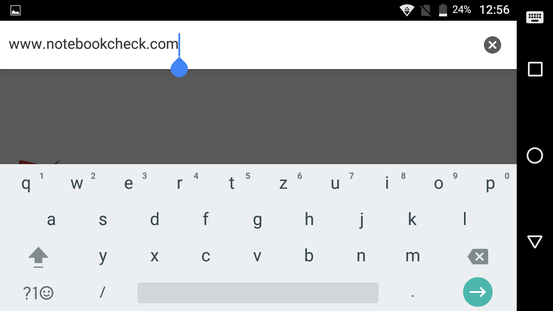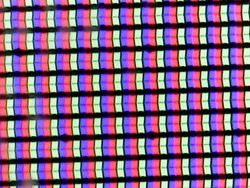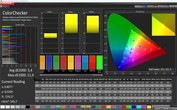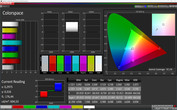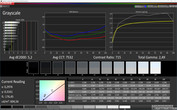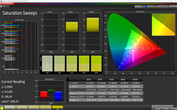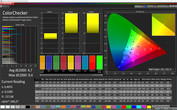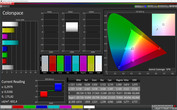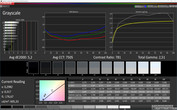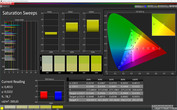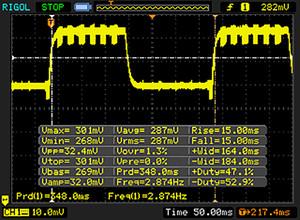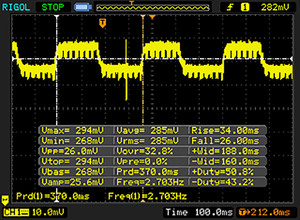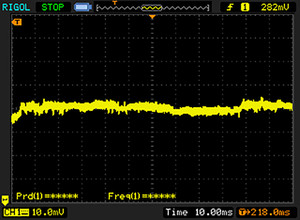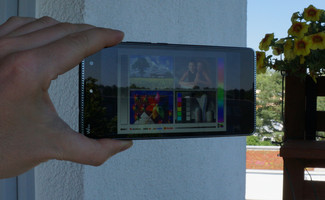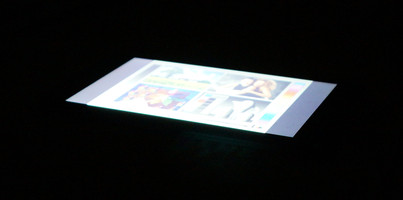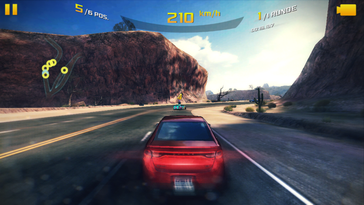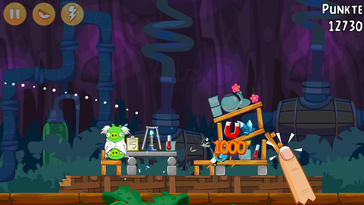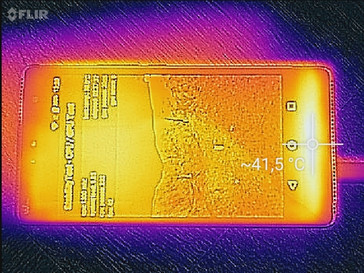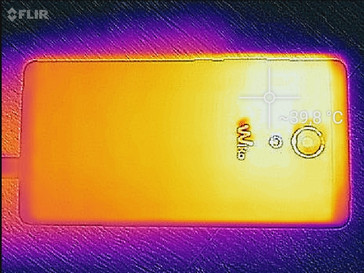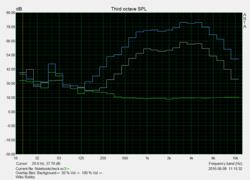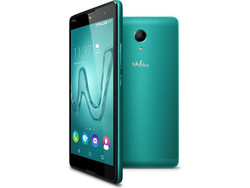Wiko Robby Smartphone Review
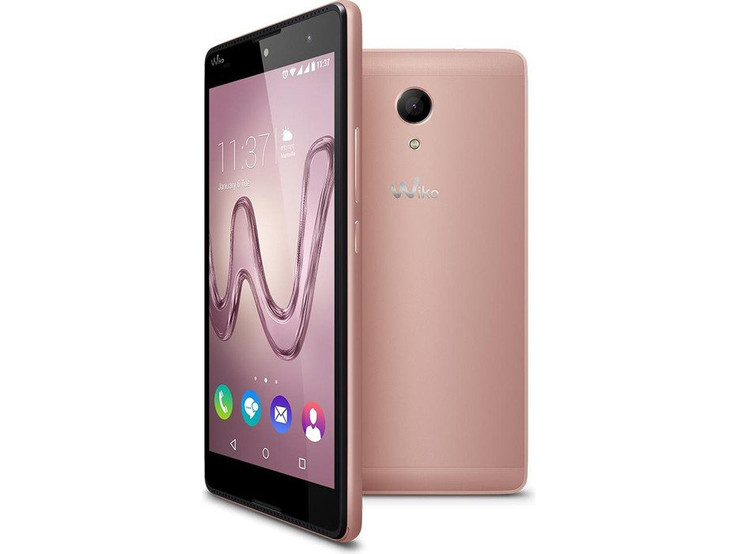
For the original German review, see here.
5.5-inch devices for under 150 Euros (~$167) are quite rare. However, the French manufacturer Wiko, known for its unusual ideas has sent us a relatively massive 5.5-inch phablet for just below 130 Euros (~$145), the Wiko Robby. Two front-sided speakers, an additional LED flash on the front and a selection of colorful casings make Robby interesting.
Several affordable smartphones are found in our database, but not many in this size. We compare LG's K7 and Samsung's Galaxy J3 that are both smaller. UMi's Touch also has a 5.5-inch screen, but it is hard to get in Europe. Asus' ZenFone Max is more expensive, but is equipped with a huge battery.
Case
Wiko's Robby is colorful: The casing is available in five different colors. Naturally, the rather formal-looking black and brown tones are among them, as well as more vivid colors such as green, blue and rose-gold. The back cover is metal while the bezel is made of plastic. The quality impression is mixed: On the one hand, the smartphone gives the impression of a decent build, but pressure quickly becomes visible on the screen and the smartphone creaks and cracks when it is twisted.
With a weight of 185 grams (~6.5 oz), Wiko's Robby is rather heavier than high-end phablets, but it is lighter than, for example, Asus' ZenFone Max with its huge battery or UMi's Touch. It has a solid feel and is not exactly slim with a height of 10 millimeters (~0.4 in).
A removable battery, two micro-SIM slots and a micro-SD slot are found under the back cover. A note beside the SIM slots states that they are not hot plugs, i.e. cards should not be swapped during use. In fact, the smartphone has to be rebooted after inserting a SIM card.
Connectivity
As mentioned before, Wiko's Robby supports two SIM cards. Both slots can access the Internet using UMTS speeds at most. The USB 2.0 port supports USB OTG, i.e. external storage devices can be connected and the system identifies them. As we inserted a USB cable, Windows started to connect and disconnect a new device haphazardly. Actually, the plug does not fit very tightly in the casing and the contact is disrupted when it is shaken. FM radio reception is possible with Wiko's Robby.
Micro-SD cards of up to 64 GB are supported. Apps cannot be moved to the SD card, but the SD card can be incorporated as an internal storage.
Software
We find it exemplary that Wiko already relies on Android 6.0 with the security patch level from May 1st, 2016. Wiko uses the so-called "My Launcher" that changes the looks of the symbols and adds some modified apps and features.
The user can access extended features via tools such as "OneClean" or "Phone Assist", for example for emptying the working memory, turning app notifications on and off or blocking calls. However, it is basically only quick access to already present features. Experienced users will see these apps as bloatware, especially since several cleaning tools exist. The energy-savings mode that Wiko advertises is now also a part of the standard Android.
Communication & GPS
Wiko's Robby does not offer LTE, but that is not common in this price range anyway. However, this is possible as UMi's Touch proves. The maximum speed is 21 Mbit per second in download and 5.76 Mbit per second in upload. The reception in an urban area using the relatively well-developed German Vodafone network was decent. We had full reception outdoors, and 3/4 of the signal strength indoors.
Buyers should be aware that the network suppliers will probably be focusing on developing LTE and its successors. The UMTS network coverage will probably decrease.
Wi-Fi can be accessed via the 802.11 b/g/n standards. Thus, using the 5 GHz band is not possible. The reception was acceptable; however, pages were not opened particularly fast, even near the router (FritzBox 6490). Only half the signal was displayed at a distance of 10 meters (~33 ft) and through three walls. Pages needed even longer to open.
The GPS reception was not strong enough for locating the smartphone indoors. It took quite a while outdoors, and then rarely did it find enough satellites to really track us reliably. The maximum accuracy, according to "GPS Test", was 20 meters (~66 ft).
Wiko's Robby was not particularly accurate on a mountain bike ride in the practical test, either. We use Garmin's Edge 500 professional navigation system for comparison. Robby already shortens the measured route by 290 meters (~951 ft), which is a noticeable difference. Robby placed us on the wrong side of the street in the crossing area, and let us "fly" over roofs. We rarely really drove on the path along the riverside, and also flew over the river if we are to believe Wiko's Robby.
Telephone & Call Quality
Although the phone app features a different logo, it is in fact Google's standard app.
The first thing we noticed during our test call was that the incorporated earpiece can be very loud. Wiko simply uses the upper speaker for this. The sound is also quite clear, but it is very treble-heavy. A subtle hum is also audible at high volumes. However, overall, the call quality is quite decent for such a low-priced handset.
The sound is no longer quite as loud when using hands-free mode and the treble-heaviness is even more audible. The microphone also functioned fairly well here.
Wiko states that the smartphone can be rotated by 180 degrees and used upside down. This is true when using the touchscreen, but does it work when making calls? In fact, Wiko's Robby simply uses the speaker that is at the top for outputting the phone's audio. However, our contact hears us much louder and clearer when we use the phone right way up. Probably, a microphone is installed only at one end.
Cameras
An 8 megapixel camera alongside an LED flash and auto focus are on the rear of Wiko's Robby. This is a good average in this price range. However, the photo quality is not very satisfactory when compared with higher-quality lenses. Details look vague and surfaces spotty when zoomed. Furthermore, bright surfaces are heavily overexposed. No details are reproduced in dark areas. The color reproduction looks rather bluish.
The front camera also has an LED flash, but only 5 megapixels. We like its color reproduction, although visible pixel spots are also evident in larger areas here. Edges often look blurred.
Overall, the low price is quite evident in the lenses. The photo quality cannot compete with higher-quality models and ranges at the lower end of acceptability for personal use.
We analyze the primary camera's sharpness and color reproduction in controlled light conditions and photograph our reference card for this. The text is clearly faded in the red field; the photos look low contrast and the colors spotty. Compared with the reference color space, the colors are displayed too bright.
Accessories & Warranty
The box of Wiko's Robby contains a charger, USB cable, headset and an adapter for different SIM card sizes. In theory, it should be possible to swap different colored back covers of Wiko Robby models, but currently they cannot be purchased separately.
Wiko includes a 24-month warranty on the smartphone, and 6 months on accessories. Naturally, this does not affect the retailer's warranty liability.
Input Devices & Handling
The touchscreen in Wiko's Robby is quite pleasant to use. It has a gliding-friendly surface and is accurate. The onscreen keyboard has not been modified. Google's standard layout is clearly arranged and straightforward and offers many additional functions when needed.
The volume control and standby button are situated on the casing's right. They are quite conspicuous and have a clear pressure point. Gestures for controlling the smartphone can be enabled in the menu. They are diverse and range from turn-to-mute up to drawing letters on the screen to open applications. The user can even configure the latter, but they function more reliably when the screen is off than when it is on.
We have already mentioned a special feature: The position sensor is configured so that it rotates the image by 180 degrees. Thus, Wiko's Robby can be used in all four directions. This is also possible because the menu buttons stay on the screen and there are no keys on the casing.
Display
Considering the price, it was almost to be expected that the screen would have a resolution of only 1280x720 pixels. UMi's Touch also offers more here with a Full HD resolution. The small letterings of the icons look quite sharp on the large screen of Wiko's Robby. Our review sample is even exemplary in brightness: The panel shines with up to 621 cd/m² (614 cd/m² in the practical APL50 test). The illumination of 88% is also relatively homogeneous. However, large white areas look slightly darker in some places.
| |||||||||||||||||||||||||
Brightness Distribution: 88 %
Center on Battery: 621 cd/m²
Contrast: 851:1 (Black: 0.73 cd/m²)
ΔE ColorChecker Calman: 4.7 | ∀{0.5-29.43 Ø4.78}
ΔE Greyscale Calman: 5.2 | ∀{0.09-98 Ø5}
Gamma: 2.51
CCT: 7505 K
| Wiko Robby IPS, 1280x720, 5.5" | LG K7 IPS, 854x480, 5" | Asus ZenFone Max ZC550KL IPS, 1280x720, 5.5" | UMI Touch IPS, 1920x1080, 5.5" | Samsung Galaxy J3 2016 Super AMOLED, 1280x720, 5" | |
|---|---|---|---|---|---|
| Screen | -63% | 4% | -17% | -16% | |
| Brightness middle (cd/m²) | 621 | 308 -50% | 586 -6% | 424 -32% | 295 -52% |
| Brightness (cd/m²) | 576 | 300 -48% | 566 -2% | 415 -28% | 299 -48% |
| Brightness Distribution (%) | 88 | 93 6% | 84 -5% | 91 3% | 96 9% |
| Black Level * (cd/m²) | 0.73 | 0.26 64% | 0.57 22% | 0.54 26% | |
| Contrast (:1) | 851 | 1185 39% | 1028 21% | 785 -8% | |
| Colorchecker dE 2000 * | 4.7 | 12 -155% | 4.2 11% | 6.9 -47% | 5.8 -23% |
| Colorchecker dE 2000 max. * | 9.4 | 25.3 -169% | 8.4 11% | 10.9 -16% | 8.6 9% |
| Greyscale dE 2000 * | 5.2 | 15.3 -194% | 6.3 -21% | 6.8 -31% | 4.8 8% |
| Gamma | 2.51 88% | 2.15 102% | 2.39 92% | 1.99 111% | 1.84 120% |
| CCT | 7505 87% | 22440 29% | 6614 98% | 8131 80% | 6252 104% |
* ... smaller is better
Then again, the black level of Wiko's Robby clearly lags behind the comparison devices, and only offers heavily backlit black areas that seem dark-gray with 0.73 cd/m². Consequently, the contrast ratio of 851:1 is just mediocre.
The screen's parameters can be set extensively via the app MiraVision that can be opened via the display settings. Two predefined modes, standard and vivid, are present, and we test the screen using these with our spectrophotometer and CalMAN software. In fact, the vivid color mode offers much stronger colors, but they also deviate more from the sRGB color space. A clear bluish cast is visible in both color modes.
Display Response Times
| ↔ Response Time Black to White | ||
|---|---|---|
| 30 ms ... rise ↗ and fall ↘ combined | ↗ 15 ms rise | |
| ↘ 15 ms fall | ||
| The screen shows slow response rates in our tests and will be unsatisfactory for gamers. In comparison, all tested devices range from 0.1 (minimum) to 240 (maximum) ms. » 79 % of all devices are better. This means that the measured response time is worse than the average of all tested devices (20.2 ms). | ||
| ↔ Response Time 50% Grey to 80% Grey | ||
| 60 ms ... rise ↗ and fall ↘ combined | ↗ 34 ms rise | |
| ↘ 26 ms fall | ||
| The screen shows slow response rates in our tests and will be unsatisfactory for gamers. In comparison, all tested devices range from 0.165 (minimum) to 636 (maximum) ms. » 96 % of all devices are better. This means that the measured response time is worse than the average of all tested devices (31.6 ms). | ||
Screen Flickering / PWM (Pulse-Width Modulation)
| Screen flickering / PWM not detected | |||
In comparison: 53 % of all tested devices do not use PWM to dim the display. If PWM was detected, an average of 8111 (minimum: 5 - maximum: 343500) Hz was measured. | |||
Thanks to the screen's high brightness, the content is still legible, even in very bright surroundings. However, due to developing reflections it is much easier on the eyes when the user looks for a shaded place.
Thanks to IPS technology, the viewing angles are quite good. However, visible brightness deviations in the image have to be accepted.
Performance
MediaTek's MT6580M, clocking at 1.3 GHz and four cores operates in our review sample. It is an entry-level SoC with very little performance. LG's K7 is based on the same SoC.
The performance deficiency compared with more expensive smartphones is very evident in routine use. Navigating is not always smooth, and loading times are noticed when switching to other apps. However, the lags are still acceptable, and it is also possible to work well with Wiko's Robby when expectations are reduced slightly. Our smartphone is clearly one of the weakest in the comparison group in the synthetic processor and system performance benchmarks.
An ARM Mali-400 MP2 GPU that clocks at 416 MHz is installed in the test device, which should be enough for basic games. Wiko's Robby lags slightly behind LG's K7, which is probably due to the screen's higher resolution.
As mentioned before, Internet browsing is a somewhat sluggish matter. Pages open slowly, but 720p YouTube videos run smoothly.
The access speed of the internal storage does not set any new records, but it achieves solid rates on category level. The same is true of the micro-SD card that we measured with our Toshiba Exceria Pro M401 reference card.
| AnTuTu v6 - Total Score (sort by value) | |
| Wiko Robby | |
| LG K7 | |
| Asus ZenFone Max ZC550KL | |
| UMI Touch | |
| Samsung Galaxy J3 2016 | |
| Geekbench 3 | |
| 32 Bit Single-Core Score (sort by value) | |
| Wiko Robby | |
| Samsung Galaxy J3 2016 | |
| 32 Bit Multi-Core Score (sort by value) | |
| Wiko Robby | |
| Samsung Galaxy J3 2016 | |
| 3DMark | |
| 1280x720 offscreen Ice Storm Unlimited Score (sort by value) | |
| Wiko Robby | |
| LG K7 | |
| Asus ZenFone Max ZC550KL | |
| UMI Touch | |
| Samsung Galaxy J3 2016 | |
| 1280x720 offscreen Ice Storm Unlimited Graphics Score (sort by value) | |
| Wiko Robby | |
| LG K7 | |
| Asus ZenFone Max ZC550KL | |
| UMI Touch | |
| Samsung Galaxy J3 2016 | |
| 1280x720 offscreen Ice Storm Unlimited Physics (sort by value) | |
| Wiko Robby | |
| LG K7 | |
| Asus ZenFone Max ZC550KL | |
| UMI Touch | |
| Samsung Galaxy J3 2016 | |
| GFXBench (DX / GLBenchmark) 2.7 | |
| T-Rex Onscreen (sort by value) | |
| Wiko Robby | |
| LG K7 | |
| UMI Touch | |
| Samsung Galaxy J3 2016 | |
| 1920x1080 T-Rex Offscreen (sort by value) | |
| Wiko Robby | |
| LG K7 | |
| Asus ZenFone Max ZC550KL | |
| UMI Touch | |
| Samsung Galaxy J3 2016 | |
| PCMark for Android - Work performance score (sort by value) | |
| Wiko Robby | |
| LG K7 | |
| Asus ZenFone Max ZC550KL | |
| UMI Touch | |
| Samsung Galaxy J3 2016 | |
| Octane V2 - Total Score (sort by value) | |
| Wiko Robby | |
| LG K7 | |
| Asus ZenFone Max ZC550KL | |
| UMI Touch | |
| Samsung Galaxy J3 2016 | |
| Mozilla Kraken 1.1 - Total (sort by value) | |
| Wiko Robby | |
| LG K7 | |
| Asus ZenFone Max ZC550KL | |
| UMI Touch | |
| Samsung Galaxy J3 2016 | |
| WebXPRT 2015 - Overall (sort by value) | |
| Wiko Robby | |
| LG K7 | |
| Samsung Galaxy J3 2016 | |
| JetStream 1.1 - Total Score (sort by value) | |
| Wiko Robby | |
| LG K7 | |
| Asus ZenFone Max ZC550KL | |
| UMI Touch | |
| Samsung Galaxy J3 2016 | |
| AndroBench 3-5 | |
| Sequential Read 256KB (sort by value) | |
| Wiko Robby | |
| LG K7 | |
| Asus ZenFone Max ZC550KL | |
| UMI Touch | |
| Samsung Galaxy J3 2016 | |
| Sequential Write 256KB (sort by value) | |
| Wiko Robby | |
| LG K7 | |
| Asus ZenFone Max ZC550KL | |
| UMI Touch | |
| Samsung Galaxy J3 2016 | |
| Random Read 4KB (sort by value) | |
| Wiko Robby | |
| LG K7 | |
| Asus ZenFone Max ZC550KL | |
| UMI Touch | |
| Samsung Galaxy J3 2016 | |
| Random Write 4KB (sort by value) | |
| Wiko Robby | |
| LG K7 | |
| Asus ZenFone Max ZC550KL | |
| UMI Touch | |
| Samsung Galaxy J3 2016 | |
| Sequential Read 256KB SDCard (sort by value) | |
| Wiko Robby | |
| LG K7 | |
| Asus ZenFone Max ZC550KL | |
| UMI Touch | |
| Samsung Galaxy J3 2016 | |
| Sequential Write 256KB SDCard (sort by value) | |
| Wiko Robby | |
| LG K7 | |
| Asus ZenFone Max ZC550KL | |
| UMI Touch | |
| Samsung Galaxy J3 2016 | |
* ... smaller is better
Games
The GPU's weaknesses are seen in the fast-paced racing game "Asphalt 8 Airborne". It can still be played in high settings, but it is not really fun since it rarely runs without stutters. The graphics unit normally achieves around 30 frames in minimum details so that the game can be played almost lag-free. Stutters and waiting times are also experienced in the menu. The racing game is playable, but details should preferably be set to medium. More basic games such as "Angry Birds" are no problem for the handset. Furthermore, control via touchscreen and position sensor function well.
Emissions
Temperature
The casing's temperatures do not cause problems. Although a maximum of 39.1 degrees Celsius (~102 degrees Fahrenheit) in the front's upper area is noticeable but it is still within limits. The maximum idle temperature of 35.2 degrees (~95 degrees Fahrenheit) is much lower. The temperature is distributed fairly evenly over the front and is lower on the rear in each case.
The stress test proves that the performance components can uphold their full power even during prolonged load.
(+) The maximum temperature on the upper side is 39.2 °C / 103 F, compared to the average of 35.2 °C / 95 F, ranging from 21.9 to 247 °C for the class Smartphone.
(+) The bottom heats up to a maximum of 37.2 °C / 99 F, compared to the average of 34 °C / 93 F
(±) In idle usage, the average temperature for the upper side is 33.7 °C / 93 F, compared to the device average of 32.9 °C / 91 F.
Speakers
The idea with the speakers is clever: Two units facing the front are as far away from each other as possible so that perhaps even a stereo effect is produced. However, unfortunately, the low price of Wiko's Robby is also reflected in the speakers. They are extremely treble-heavy. Songs sound as if they are sent through a metal pipe; they have a strange echo and the individual sounds often merge to an undefinable sound mix. At least, the speakers are quite loud at over 89 dB(A), and transmit speech relatively well.
Connecting headphones to the 3.5 mm jack leads to a clear sound. "3D Sound by Auro-3D" that audibly changes the sound is enabled automatically. It is possible to switch to stereo mode via a click, which we perceived as considerably more pleasant. Connecting a Bluetooth headset also functioned without any issues.
Energy Management
Power Consumption
Despite its low performance, Wiko's Robby is not exactly energy saving when compared with other devices. Of course, it should be remembered that Robby is equipped with a larger screen that consumes a considerable part of the energy in many scenarios. The rates are pleasingly low in off and standby. Thus, it is possible to leave the smartphone unused for a prolonged period of time and still have battery power afterward.
However, Wiko's Robby consumes considerably more power than the comparison devices already in idle mode. It is also one of the highest consumers during load.
| Off / Standby | |
| Idle | |
| Load |
|
Key:
min: | |
| Wiko Robby 2500 mAh | Asus ZenFone Max ZC550KL 5000 mAh | LG K7 2125 mAh | UMI Touch 4000 mAh | Samsung Galaxy J3 2016 2600 mAh | |
|---|---|---|---|---|---|
| Power Consumption | -5% | 38% | 9% | 38% | |
| Idle Minimum * (Watt) | 0.92 | 1.15 -25% | 0.61 34% | 0.89 3% | 0.96 -4% |
| Idle Average * (Watt) | 2.12 | 2.09 1% | 1.36 36% | 2 6% | 1.14 46% |
| Idle Maximum * (Watt) | 2.34 | 2.17 7% | 1.38 41% | 2.1 10% | 1.23 47% |
| Load Average * (Watt) | 5.3 | 5.38 -2% | 3.11 41% | 3.87 27% | 2.45 54% |
| Load Maximum * (Watt) | 5.78 | 6.08 -5% | 3.59 38% | 5.79 -0% | 2.92 49% |
* ... smaller is better
Battery Runtime
On the other hand, Wiko's Robby achieves quite good runtime rates. Although the idle and load runtimes are shorter than the comparison devices, with only a 2500 mAh or 9.5 watt battery Wiko's Robby presents a very good rate of 11.52 hours in the Wi-Fi test. Only the ZenFone Max with a battery that has twice the capacity can distance itself here.
Wiko's Robby will probably last two days without recharging when used moderately in practice. However, it will have to be connected to the outlet every night when used excessively.
| Wiko Robby 2500 mAh | Asus ZenFone Max ZC550KL 5000 mAh | LG K7 2125 mAh | UMI Touch 4000 mAh | Samsung Galaxy J3 2016 2600 mAh | |
|---|---|---|---|---|---|
| Battery runtime | 34% | -1% | -23% | 29% | |
| Reader / Idle (h) | 20.9 | 16.7 -20% | 20.2 -3% | ||
| WiFi v1.3 (h) | 11.9 | 16 34% | 7.6 -36% | 9.2 -23% | 8.4 -29% |
| Load (h) | 3.3 | 5 52% | 7.2 118% | ||
| H.264 (h) | 5.2 | 9.8 |
Pros
Cons
Verdict
Two speakers in a "Metal Design" casing, 5.5-inch screen for little money: Wiko's Robby sounds almost too good to be true at almost 130 Euros (~$145). In fact, it proves to be a cheater in many aspects: Only the bezel is metal, the casing is plastic; although two speakers are installed on the front, their sound is abysmal. Only the 5.5-inch screen is really convincing in view of the price. It is bright, offers a lot of space, a suitable resolution and provides extensive settings.
If anything, we liked the setting options and software of Wiko's Robby: An up-to-date Android is preloaded, additional gestures for controlling the handset can be enabled, and audio improvement software is present. Wiko has gone too far with two energy saving modes and three memory cleaning options.
USB OTG and the option of formatting SD cards for internal use are decent configuration features. Unfortunately, App2SD is not supported. LTE is also absent; other smartphones in this price range offer the faster network standard. We deduct a percentage point for the poor reception and slow speeds in both the Wi-Fi and UMTS networks and GPS scanning.
Wiko's Robby uses fresh colors and metal back to cover up some shortcomings.
The rather poor photo quality of the cameras does the rest so that we cannot unconditionally recommend Wiko's Robby. Only buyers who categorically want a 5.5-inch screen for very little money could take a look at the handset.
Wiko Robby
- 06/27/2016 v5.1 (old)
Florian Wimmer










